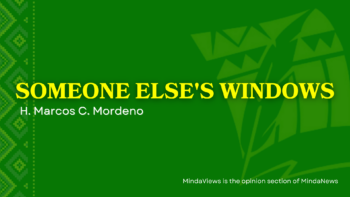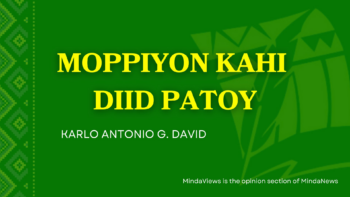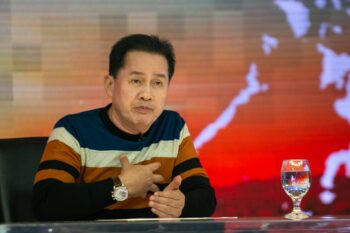
ZAMBOANGA CITY (MindaNews / 6 June)—I was watching a YouTube video about a Japanese couple named Kenji and Tomoko and their transition to a rural permaculture homestead. The video was produced by Growing Small, an organization that promotes natural building, permaculture, and simple living.
This type of advocacy deeply resonates with me, as I was introduced to personal peace and environmentalism during my Ph.D. program. It is a lifestyle that I strive to embrace, even though it is not commonly pursued by many.
I recall my adolescence period in Bongao. Gone is the laidback town that allowed us to live a modest life even with limited money. These days, every movement requires money to pay for a tricycle to get around (the town used to be a walkable community), to pay for water (we used to harvest rainwater), and so on. Food used to be shared, and raw food was accessible for many. Now, a large cuttlefish costs just P150 per piece at the farmer’s market in Batu-Batu (Panglima Sugala), but in Bongao, it goes up to P180 per kilo. Seafood used to be sold in “tumpok-tumpok” (bundles), now it is weighed. The town that used to enjoy fresh air and a clean environment now faces similar problems to Metro Manila, such as garbage, pollution, traffic, migration, and so on. Pervasive challenges for the town leaders.
One might say that watching Kenji and Tomoko is like a nostalgic journey to a bygone era of Bongao. I strongly believe that we need to be selective in embracing modernization and be conscientious as a society in making our choices and adopting a mitigative approach. And this situation cannot be left to the government alone, the residents and civil society have responsibilities as well. We must recognize that the primary cause of climate change is our own actions and daily behaviors. We cannot solely rely on survival instincts and selfishly focus on ourselves and our immediate families. Instead, we should progress with a focus on sustainability, considering the future generations of our children and their descendants.
Kenji and Tomoko are exemplifying a different way of life, one that deviates from consumerism. Their lifestyle contradicts the urbanized and consumerist norms that have contributed to global warming and climate change. In their video, they share five key principles or secrets to enjoying their preferred way of life, which is based on their permaculture homestead. These principles include: (1) cultivating a garden, (2) living a simple life, (3) harmonizing with nature in construction, (4) preserving seeds, and (5) investing in meaningful connections.
Grow a garden
Growing a garden not only provides nourishment for the body but also cultivates peace of mind and a sense of security. When I hear the line, “We grow what we eat, and we eat what we grow,” I recall the inspiring figure of Perfecto “Jojo” Rom, a trailblazer in urban container gardening in Mindanao, Philippines. It is important to recognize that food serves as a form of medicine for many lifestyle ailments prevalent today. By engaging in gardening, we establish a deeper connection with our immediate environment and foster a sense of security. One common misconception about gardening in urban or rapidly urbanizing areas is the perceived lack of available land. However, Jojo Rom aptly emphasizes that a garden does not require vast tracts of land; rather, it only necessitates a dedicated space to set it up.
Unlike unsustainable monoculture farming, Kenji and Tomoko’s farm embraces diversity. They believe that the soil and the surrounding environment should guide their choices of fruits, vegetables, and poultry, selecting varieties that are well-suited and complementary to one another. In monoculture farming, grass is considered an enemy, but in permaculture, it serves many purposes and one of them as an organic mulching aid. This approach transforms the garden into a multifunctional space, serving as a food bank, medicine cabinet, and spiritual sanctuary all at once. Kenji and Tomoko draw inspiration from the teachings of Masanobu Fukuoka, a farmer-philosopher who advocates for natural farming methods. These methods involve eschewing tilling, herbicides, and pesticides in cultivation.
I feel fortunate to have witnessed my maternal grandparents practicing these sustainable farming techniques. For them, farming and fishing were integral parts of their daily lives, and retirement was inconceivable. As my maternal grandmother used to say, to retire is to die. Even in her 70s, when she no longer needed to farm for a living, she continued to cultivate the land, harvest fruits, herbs, vegetables, and seeds, making them an integral part of her daily routine, her daily purpose aside from her religious rituals.
Live simply and meaningfully
A permaculture homestead not only encourages us to live in harmony with nature but also to lead a simple yet fulfilling life. This kind of life is achieved by dedicating ourselves to working in the garden and finding contentment in what it provides, along with the nearby forest. Surprisingly, I have rarely heard people discuss the merits of frugal living.
In a world dominated by consumerism and materialism, the focus tends to be on the latest fashion trends and high-end brands, leading to the constant desire to accumulate more and more possessions. This unsustainable and want-driven lifestyle is heavily reliant on money. Money has now become a prominent symbol of success, often measured by the amount one has accumulated. It is no wonder that many of us choose professions that promise easy financial gain. I vividly recall a university president expressing her concern about the lack of participation among graduates in their volunteer program. This prompted her to invite a young lady to share her experiences as a religious missionary, with the hope of inspiring the hearts of over 4,000 graduates this year.
Living a permaculture lifestyle is not about making money. In our Filipino culture, where financial success is often equated with achievement, it can be puzzling for many of us to comprehend why someone would choose a religious vocation or live a lifestyle that is not centered around monetary gain. We find ourselves asking questions like, “Bakit?” (Why) and expressing sentiments such as, “Sayang naman, matalino pa naman siya!” (What a waste, they’re so intelligent!).
Truly, it is challenging to grasp the mindset of individuals like Kenji and Tomoko, who are driven by a different set of values and find contentment through a non-materialistic approach. Engaging in activities like yoga and meditation at the start of their day is foreign to a society that is constantly “naghahabol sa oras” (chasing after time) and “pinagkakakitaan ang oras” (monetizing every moment). In Kenji and Tomoko’s lifestyle, the focus lies not in accumulating wealth but in living each day with purpose. They prioritize clarity and intention, seeking meaning in their daily lives rather than pursuing financial gains. Moreover, their commitment extends beyond consuming natural food; they strive to align their entire lifestyle with the principles of nature.
Build with nature
Growing up in Tulay (Jolo, Sulu) and on Boan Island (Panglima Sugala, Tawi-Tawi), I have vivid memories of how house building or repair used to be a collective or communal affair. In those days, no one was left homeless because the entire community would come together to help. Sustainable construction materials were readily available and abundant. However, as time passed, we transitioned from this traditional approach to a new paradigm where house construction became a business endeavor. Unfortunately, this shift has led to an increase in the number of homeless families, as building houses is no longer a communal and collective concern but rather a profit-driven enterprise. Presently, we witness the privatization of public lands, with forests being converted to accommodate agriculture, housing, and industries. Consequently, it is alarming that floods, landslides, and other natural calamities are becoming more severe. These changes in land use and the depletion of natural resources have undoubtedly contributed to the worsening of these disasters.
It is disheartening to reflect on how the sense of community and collective responsibility, which once ensured that everyone had a place to call home, has been eroded. We now face the consequences of prioritizing profit over the well-being and safety of our fellow community members. It is crucial for us to recognize the interconnectedness between our actions and the environment. By adopting sustainable practices, fostering a communal spirit, and prioritizing the welfare of all, we can begin to address the challenges we currently face.
When we discuss human rights, does housing for a family fall under its umbrella? However, due to a profit-driven mindset, we find ourselves constructing taller and narrower vertical buildings. This approach disconnects us from our natural and communal surroundings. Even government housing projects are indistinguishable from those undertaken by private contractors, but with the added detriment of corruption allegations. Consequently, future generations are growing up in artificial urban environments characterized by divisions based on socioeconomic status. These divisions are reinforced by high concrete fences, sterile gardens, and air-conditioned fitness rooms. As a result, our children are becoming passive and overly reliant on electronic devices, rather than engaging in physical activities and socializing with neighbors. Whereas in the past, we struggled to get them indoors, now we struggle to get them outside into the yard.
Kenji and Tomoko’s homestead presents a compelling model for us to consider. They construct facilities using locally-available and sustainable materials. In their construction approach, they draw inspiration from renowned architects such as Gaudi, Steiner, Humboldt, Wester, and Wright, particularly emphasizing the use of curved structures for both stability and aesthetic appeal. By doing these, they are attracting people to listen and experience their advocacy, and thereafter, begin the willingness to apply some of it in their lives as well.
Save seeds
We live in a world dominated by convenience, fast foods, and supermarkets, where these goods can be obtained instantly at a mall with money. Consequently, the mall and the possession of money have become synonymous with our artificial and unsustainable lifestyle. The allure of a mall-driven lifestyle contributes to the phenomenon of urban migration, exerting a comparable influence to that of the media. Being observed shopping at the mall is perceived as a symbol of a successful lifestyle, envied and emulated by others.
In such a context, why bother saving seeds when we can readily purchase their fruits whenever we desire? A seed bank, however, represents the vast diversity of the garden and embodies our foresight for the long term, encompassing virtues such as patience, persistence, and stamina. Although we may quantify seeds in numbers, it is important to remember that saving a single seed can potentially yield hundreds more when planted and harvested. Natural seeds also differ from commercially produced and genetically modified ones. While amassing an ample supply of natural seeds, we also have an opportunity to share them with others.
The act of sharing stands in stark contrast to the prevailing individualism, materialism, and consumerism of the modern world. In our individualistic and materialistic society, there is a relentless pursuit of accumulation, a constant race to be unique and distinct. Sharing what we possess does not necessarily make us stand out from the crowd.
Many individuals are willing to share information on where to buy, but not necessarily to give away what they already have. Establishing a seed bank cultivates a generous spirit and promotes a lifestyle that is urgently needed in a time of widening socioeconomic divisions and escalating poverty.
Invest in connections
Many things are accomplished by making connections, said Kenji. On its own, straw is a useless construction material. But when mixed with soil and plastered, it can support a structure. By making connections, materials acquire new characteristics. Now, imagine this applied to humans.
Kenji and Tomoko have built a guesthouse and opened their permaculture homestead, creating a space where people can learn about their pursuits and build relationships around their advocacy and with one another. Kenji reminisces about the old practice of exchanging goods and sharing one’s life with others, a tradition that was replaced by the convenience of money. However, nowadays, it seems more important to prioritize the pursuit of money rather than building meaningful relationships and connections.
So, I am fascinated by the work being done by Muneer Arquion Hinay, based in Zamboanga. His work revolves around organic food, food security and local food system, but what truly sets him apart is his focus on building connections among people. It is through these connections that his initiative thrives, fostering meaningful human relationships that were previously absent. By doing so, he is bridging the gap between the privileged and the disadvantaged, the powerful and the powerless. In this process, he helps us rediscover our shared humanity, which often gets eroded by the pressures of individualism, materialism, and consumerism in the modern world.
However, these connections are not solely driven by needs; they also serve to strengthen social cohesion across socio-economic divisions, with the hope of eventually narrowing these divides. According to Kenji, permaculture is a discipline that emphasizes integration, allowing us to become one with nature. Rather than seeking superficial titles and material wealth, we enrich our lives by striving to become our best selves and finding our purpose through nature’s guidance.
Ralph Waldo Emerson, the 19th-century American philosopher, reflected on success and had this to say: “To laugh often and much; to win the respect of intelligent people and the affection of children; to earn the appreciation of honest critics and endure the betrayal of false friends; to appreciate beauty; to find the best in others; to leave the world a bit better, whether by a healthy child, a garden patch, or a redeemed social condition; to know even one life has breathed easier because you have lived. This is to have succeeded!” However, many of these successes can only hold relevance and meaning when one is introspective about their influence and in tune with the natural environment. In short, they are more meaningful in a permaculture lifestyle than in our modern lifestyle driven by individualism, materialism, and consumerism.
(MindaViews is the opinion section of MindaNews. Noor Saada is a Tausug of mixed ancestry—born in Jolo, Sulu, grew up in Tawi-Tawi, studied in Zamboanga and worked in Davao, Makati and Cotabato. He is a development worker and peace advocate, former Assistant Regional Secretary of the Department of Education in the Autonomous Region in Muslim Mindanao, currently working as an independent consultant and is a member of an insider-mediation group that aims to promote intra-Moro dialogue.)







